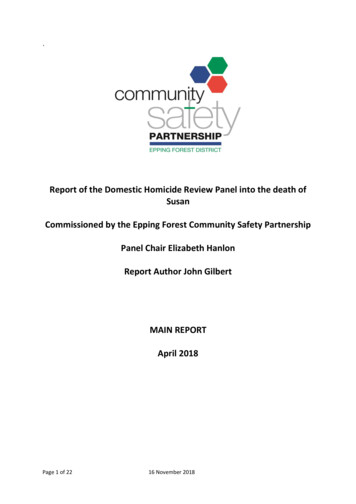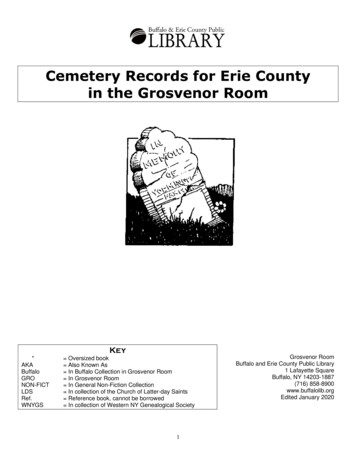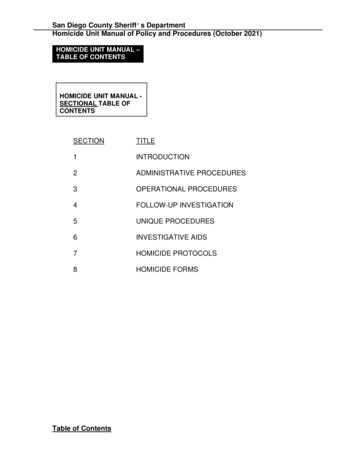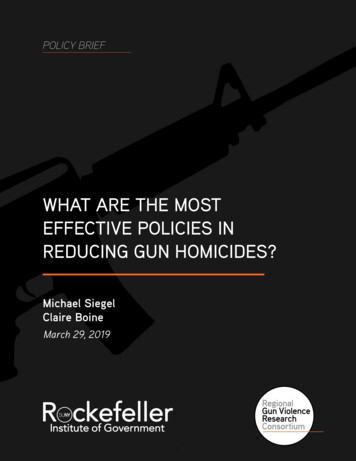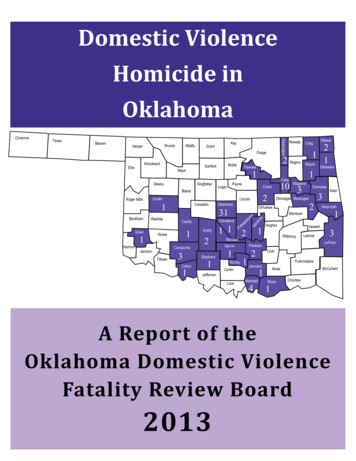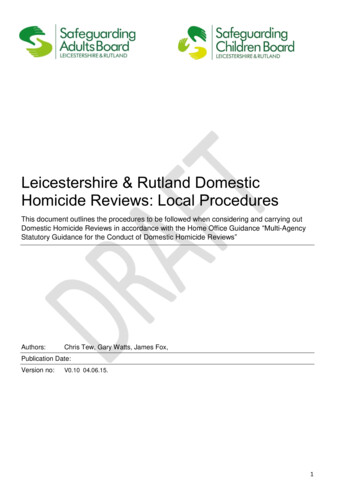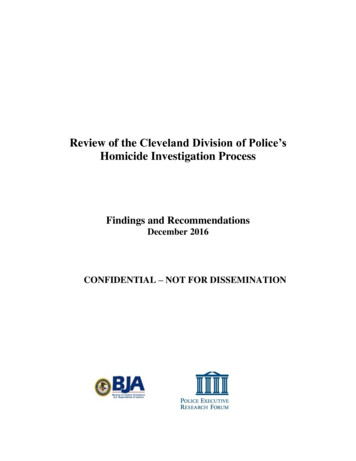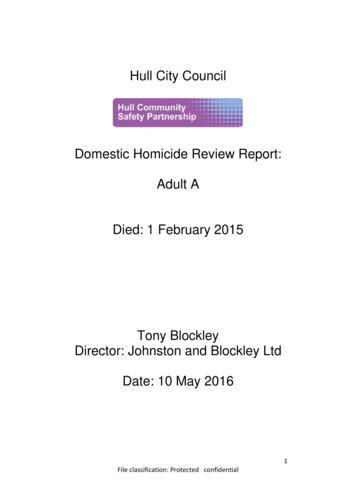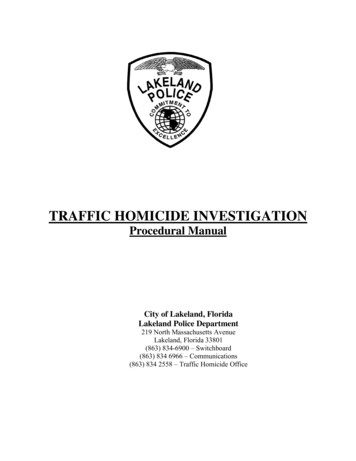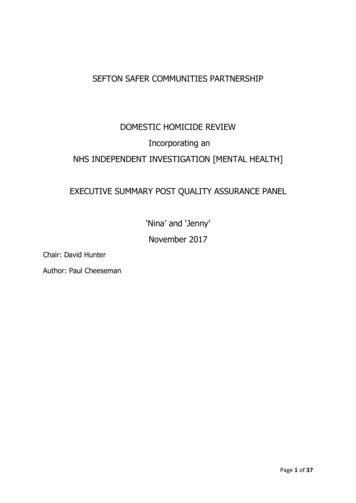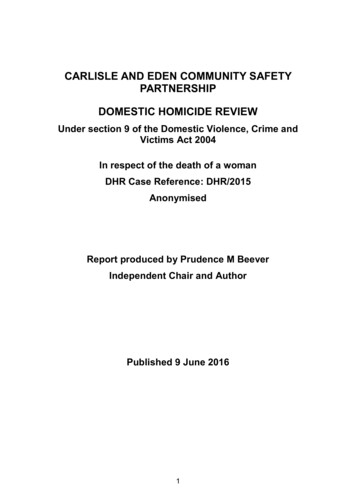
Transcription
CARLISLE AND EDEN COMMUNITY SAFETYPARTNERSHIPDOMESTIC HOMICIDE REVIEWUnder section 9 of the Domestic Violence, Crime andVictims Act 2004In respect of the death of a womanDHR Case Reference: DHR/2015AnonymisedReport produced by Prudence M BeeverIndependent Chair and AuthorPublished 9 June 20161
Glossary of abbreviations:ASCAdult Social Care, Cumbria County CouncilC&ECSPCarlisle and Eden Community SafetyPartnershipCCGClinical Commissioning GroupCHESSCare Home Education and Support ServiceCMHNCommunity Mental Health NurseCPNCommunity Psychiatric NurseCPFTCumbria Partnership NHS Foundation TrustCSPCommunity Safety PartnershipCQCCare Quality CommissionDASHDomestic Abuse, Stalking and Honour BasedViolenceDHRDomestic Homicide ReviewDSSDementia Support ServicesECAEden Carers AssociationEMIElderly Mentally InfirmIASIntegrated Adult SystemIMRIndependent Management ReviewMAPPAMulti-Agency Public Protection ArrangementsMARACMulti-Agency Risk Assessment ConferenceMCAMental Capacity ActMHAMental Health ActSWSocial Worker2
Section One: Introduction and Background .41.1Introduction .41.2Brief History .41.3Purpose of a Domestic Homicide Review. .51.4The Review Process .61.5Independent Chair .81.6DHR Panel and Terms of Reference .91.7Parallel Proceedings .101.8Chronologies .111.9Time Period .121.10 Key Lines of Enquiry .121.11 Contact with Family and Friends .131.12 Summary of Key Events .141.13 Individual Management Reviews .18Section Two: Key Events and Analysis of Agency and Other Interventions .202.1Cumbria County Council Adult Social Care .202.2Cumbria CCG - Brampton Medical Practice .352.3JK House Care Home .412.4Cumbria Partnership Foundation Trust .482.5Cumbria Constabulary .512.6Alzheimer’s Society .522.7Views and Opinions of Friends and Family .53Section Three: Recommendations.603.1DHR Overview.603.2Risk Factors Affecting the Couple .613.3Examination of Why and How Events Occurred .623.4Lessons to be learnt .633.5SMART Recommendations .65Section Four: Conclusion .683
Section One: Introduction and Background1.1IntroductionThis report of the Domestic Homicide Review (DHR) examines the circumstancesleading up to the death of Mrs A M, date of birth 22 June 1934, aged 80 years, by herhusband Mr B M on 2 September 2014.Plain English has been used where possible in the production of this report.1.2Brief HistoryMr and Mrs M were retirees in their 80s. They were both academics and had come tolive in an isolated rural spot with only two neighbours, a couple living within thevicinity, who, over time, became their friends and a source of support.On the morning of 2 September 2014, the police received a call from B M at 6.16amstating that he thought his wife was dead. He informed the call handler that he was ill,he could not talk and was going to sleep. Officers were immediately deployed andarrived at his home address at XXXXXX, Cumbria. Mr M told them that his wife wasdead upstairs in the house. He informed the officers that he had tried to kill himself inhis car by placing the exhaust pipe inside his vehicle.Officers found the car with a pipe in the vehicle and a strong smell of fumes within thegarage. His wife was located upstairs with a plastic bag and pillow over her headwhich was weighted down. She was confirmed deceased by paramedics at 6.50pm.Mr M was arrested and was taken to be medically examined at Cumberland Infirmary.He was later formally charged with the murder of his wife by Cumbria Police. He wasremanded in custody with the support of a psychiatric report, until given bail on appealon 13 October 2014. There were address and reporting conditions imposed at theCrown Court. He was found dead by the River Eden on 11 December 2014.The death of Mr M is the subject of a separate internal review by Cumbria PartnershipFoundation Trust. Evidence from this review has been shared with them to avoidduplication of documentation and interviews of key witnesses.4
1.3Purpose of a Domestic Homicide ReviewThe Domestic Violence, Crime and Victims Act 2004 establishes at section 9 astatutory basis for a Domestic Homicide Review, which was implemented with dueguidance on 13 April 2011. Under this section, a Domestic Homicide Review (DHR):“means a review of the circumstances in which the death of a person aged 16or over has, or appears to have, resulted from violence, abuse or neglect by:a) a person to whom he was related or with whom he was or had been in anintimate personal relationship, orb) a member of the same household as himself, held with a view to identifyingthe lessons to be learnt from the death.”Domestic Homicide Reviews are not inquiries into how a victim died or who is toblame. These matters are for Coroners and criminal courts. Neither are they part ofany disciplinary process. The purpose of a DHR is to: Establish what lessons are to be learnt from the homicide regarding the way inwhich local professionals and organisations work individually and together tosafeguard the victim. Identify clearly what those lessons are both within and between agencies, howand within what timescales they will be acted on, and what is expected tochange as a result. Apply these lessons to service responses, including changes to the policies andprocedures as appropriate. Prevent domestic homicide and improve service responses for all victims andtheir children through improved intra- and inter-agency working.5
1.4The Review ProcessCumbria Constabulary notified Adult Social Care (ASC) electronically on 2 September2014 at 1.15pm of the death of Mrs A M. An initial meeting was held on 11 September2014 chaired by DB, Safeguarding Adults Officer.Other attendees included Mrs M’s social worker (SW), and representatives from theCare Home Education and Support Service, Cumbria NHS, Cumbria PartnershipFoundation Trust (CPFT), and several members of Cumbria Police. Mrs M’s GP hadalso provided a synopsis of her (the GP’s) involvement.The purpose of the meeting was to gather information surrounding Mrs M’sunexpected death and to decide whether further action or investigation was required,and whether or not input was required from Adult Social Care. The outcome couldhave been a progression towards a serious case review and further investigation, orthe necessary answers could have been found at the meeting. It appears that nodecision was taken to progress the matter further at that stage.A second meeting did take place, however, on 1 October 2014, chaired by the Chairof the Carlisle and Eden Community Safety Partnership. Other attendees were alsomembers of the Community Safety Partnership. It was pointed out that section 3 (para18) of the Home Office Multi-Agency Statutory Guidance for the Conduct of DomesticHomicide Reviews states that when a domestic homicide occurs, the relevant policeforce should inform the relevant Community Safety Partnership (CSP) in writing of theincident. No such letter had been received and the Police representative agreed toforward one. After much discussion, it was agreed by the group that whilst the incidentwas a domestic homicide, there was no previous history of any involvement by thepolice or other agencies in relation to domestic violence between Mr and Mrs M; it wastherefore felt that it was not necessary to undertake a Domestic Homicide Review.The Group did feel that an internal review would be appropriate to establish whatlessons, if any, could be learnt to prevent anything similar occurring in the future. Itwas agreed to approach the current Chair to assist with the internal review.On 29 October 2014, the Home Office was notified that a DHR would take place.The Author was requested to accept the appointment on 21 November 2014.The Police and Crime Commissioner’s Office agreed to fund the DHR.6
The initial pre-Panel meeting to discuss the appointment of Panel members took placeon 12 December 2014. Panel members were appointed and requests were made bythe Chair for basic information to be shared.The first Panel meeting took place on 21 January 2015, chaired by the Author of thisreport. The purpose of the meeting was to agree the scope of the review, and it wasconsidered that it might be appropriate to undertake a review into the death of Mr M toavoid some duplication of work. However, it was recognised that it would have to be aseparate piece of work as it could not form part of the DHR itself.The number of statutory agencies involved with the family was quite wide. It wasagreed which friends and family members should be approached.Target dates were agreed for completion of the enquiries and for submission of thereport.Chronologies were requested, and due to the likely number of these it was determinedthat Independent Management Reviews (IMRs) would be requested after perusal ofthe chronologies. All of these were received by 25 February 2015 as requested, a totalof 13 in all.The second meeting took place on 27 February 2015. It was agreed that IMRs wouldbe requested from: Cumbria County Council Adult Social Care Cumbria CCG - Brampton Medical Practice JK House Care Home Cumbria Partnership Foundation Trust Cumbria Constabulary Alzheimer’s SocietyFurther clarification from some or all of the other agencies would be requestedthereafter if required.7
1.5Independent ChairThe Home Office Guidance requires that:“The Review Panel should appoint an Independent Chair of the Panel who isresponsible for managing and coordinating the review process and forproducing the final Overview Report based on IMRs and any other evidence theReview Panel decides is relevant.”and“The Review Panel Chair should, where possible, be an experienced individualwho is not directly associated with any of the agencies involved in the review.”Mrs Prudence Beever was appointed on or about the end of November 2014. She is aBarrister-at-Law with over 30 years’ experience. She has extensive knowledge ofdomestic violence and abuse, honour killings and abduction and forced marriages.She has experience in many other areas of abuse, including serious and sometimesfatal abuse of children. As this was her first Domestic Homicide Review, Home Officeonline training took place, and study and research into the subject of DHRs, and inparticular suicide/homicide cases and studies, were undertaken before taking the firstmeeting. In addition, voluntary mentoring was requested and undertaken with anexperienced Chair of DHRs throughout the process.Mrs Beever has had no involvement either directly or indirectly with members of thefamily concerned, or the delivery or management of services by any of the agencies.She has attended and chaired the meetings of the Panel, the members of which havecontributed to the process of the preparation of this report and have helpfullycommented upon it. All information was received in a timely manner from theagencies.Unfortunately the review was delayed by just over a month, due to a bereavement inthe Chair’s immediate family.8
1.6DHR Panel and Terms of ReferenceIn accordance with the statutory guidance, a DHR Panel was established to overseethe process of the review. Mrs Beever chaired the Panel and is also the author of theOverview Report. Other members of the Panel and their professional responsibilitieswere: Safeguarding Adults Service Manager, Health and Care Services, CumbriaCounty Council Detective Inspector for North Cumbria Constabulary Development Officer for Mentally Disordered Offenders (Cumbria), CumbriaPartnership NHS Foundation Trust Head of Lancashire and Cumbria Crown Court Prosecutions Unit, CPS(extended leave prior to completion of the review) Communities Director Eden District Council GP Safeguarding Lead for Adults in Cumbria, NHS Commissioning Group NHS England, Quality and Safety Manager, Cumbria, Northumberland, Tyneand Wear Area Team. Later replaced by: Senior Quality and Safety Manager, Cumbria Partnership NHS FoundationTrustThe Community Safety Manager Cumbria County Council, was originally a member ofthe Panel but had been offered a post elsewhere and was unable to attend furthermeetings.9
Terms of reference were to: Establish whether it was known, or could have been suspected, that theperpetrator posed a serious risk of harm to his wife, the victim, and whether anyaction could have been taken to prevent the homicide. To establish whether thedomestic homicide was predictable or preventable. Identify how effective agencies were in identifying the victim’s vulnerability todomestic abuse/homicide and whether the risks were identified andappropriately managed. Identify how effective agencies were in identifying the risks that the perpetratorposed to the victim (or himself), and how such risks were managed. Establish how agencies work together and to identify any gaps and/or changesthat are required to strengthen inter-agency working, practice, policies orprocedures to improve the identification of people who may be subject to therisk of abuse and homicide within Cumbria and beyond.1.7Parallel ProceedingsThe first Panel meeting took place after the death of the perpetrator. It became clearafter the death of Mr B M that a review of his death (suspected suicide) would alsohave to be undertaken. The Panel members were keen to avoid any duplication ofwork, but recognised that it was outwith the scope of the DHR to cover thecircumstances surrounding Mr M’s death. However, there is considerable scope forthe sharing of information gathered in this review with CPFT, which is to carry out theinternal review.The Chair advised the Coroner that a DHR was taking place and requested sharing ofhis reports and enquiries. The DHR and the Coroner’s Office did exchangeinformation. The Coroner’s Regulation 28 report was also provided on request.10
1.8ChronologiesThe process began with an initial scoping exercise prior to the first Panel meeting.This was confirmed at a pre-Panel meeting chaired by the Panel Chair. The agenciesinvolved or likely to have been involved with the victim and perpetrator were identifiedfurther at the first Panel Meeting, as well as those agencies and charitableorganisations to which the couple were referred.Thirteen agencies responded that they had recorded contact with Mr and/or Mrs Mand/or held information that was relevant to the scope of the review. They submittedto the Panel with chronologies: Cumbria Partnership Foundation Trust (Mrs M) Cumbria Partnership Foundation Trust (Mr M) North Cumbria University Hospital Crown Prosecution Service Adult Social Care, Cumbria County Council Alzheimer’s Society Cumbria Constabulary Mr M’s GP, Brampton Medical Practice Mrs M’s GP, Brampton Medical Practice JK House Care Home North West Ambulance Service Penrith Mountain Rescue Team Durham PrisonThe following agencies/organisations indicated that they either had no recordedcontact with the victim or Mr M, or that any contact was out of scope and was not ofrelevance to the review, or that the information they provided was of minimalassistance to the review: Eden Carers Association Crossroads CareAgencies were asked to give chronological accounts of their contacts with the victimand the perpetrator prior to the homicide.11
Where agencies had no involvement or insignificant involvement, they informed thereview accordingly.In line with the terms of reference, the DHR has covered in detail the period fromFebruary 2012 to the date of Mrs M’s death. A comprehensive chronology wasformulated from all of the chronologies received to assist with the enquiries and placeevents into context.The organisations that completed an IMR have responded with information indicatingsome level of involvement with the family.A combined chronology was undertaken to assist in the process of more fullyunderstanding the events that occurred and decisions taken up to the date of death.1.9Time PeriodThe review covered the time period from approximately February 2012 until2 September 2014, when Mr M called the police after killing his wife. The review alsoconsidered relevant information from individuals and agencies from their contact withthe perpetrator after that time period, in order to gain insight into the state of hismind/thinking processes before he was eventually found dead.1.10 Key Lines of Enquiry History of events and relationshipsWhat was known about the perpetrator’s relationship with his wife? What wasthe sequence of events leading up to the date of the homicide? Information and assessmentsHow was information about Mr and Mrs M received and addressed by theagencies? What assessments were completed and what was the outcome ofthese? Were there trigger points or missed opportunities for sharing informationthat would or could have made a difference? What were the thresholds fordecision making?12
Risk assessmentsWhat risk assessments were completed to a) assess the risks to the victim andb) to assess the risks posed by the perpetrator? Did the perpetrator have ahistory of violence and, if so, how was this managed? What were the outcomesof any risk assessments? Were these completed on a single agency basis orjointly with other agencies? What actions were taken? Contact with and support from agenciesWhat contact did each agency have with the victim and the perpetrator? Whatsupport did each receive and from whom? What processes were followed andwhat were the key decision points and why? Was there any additional actionthat could have been taken and would it have made a difference? Adult safeguardingWere there any safeguarding issues in respect of the victim and, if so, werethese appropriately managed? Awareness of domestic abuse indicatorsTo what extent are staff and agencies aware of the indicators of risk in thesecircumstances? Were these appropriately identified and what action was taken?Does the agency have policies and procedures in place for dealing withconcerns about the possibility of the existence of elderlyabuse/homicide/suicides?1.11 Contact with Family and FriendsTwo members of the immediate family and the M’s immediate neighbours wereinterviewed by the Panel Chair after permission was sought from them directly orthrough their solicitors. They were provided with a sensitively worded explanatoryleaflet and introductory letter. Their statements were sent to them for approval.A meeting was arranged by the Chair with the District Coroner. He kindly provided afull bundle of Inquest documents which was due to be heard in July 2015, strictly forconsideration only by Panel members.13
1.12 Summary of Key EventsThis history has been taken from a wide number of different sources, including ASC,GP records, JK House Care Home, the police and other emergency services, andfamily and friends. The combined chronology assisted in the process.Mr and Mrs M were both intellectual retirees in their 80s. They had been married forover 50 years. They lived alone in a fairly remote part of the Eden Valley in Cumbria,and their only immediate neighbours were Mr and Mrs K. They saw little of their family,who lived in the USA and Australia. There had been some visits now and then. All theevidence suggests that they were individuals who were independent-minded anddevoted to one another.Concerns over the victim’s mental health were first raised in March 2012 when MrsM’s memory was noted to be poor. She was eventually diagnosed with Alzheimer’stype dementia on 7 June 2012. There is some reference on 20 March 2012 from theperpetrator’s son to the GP to his father having a history of depression. It becameclear from the GP records that depression had been a long-standing issue for Mr M.Mrs M was prescribed medication to slow down the onset of her condition by her GP,but it seems both Mr and Mrs M were resistant to her taking any medication and,indeed, it appears that the victim did not take her prescribed medication. Mrs M hadbegun wandering away from her home and getting lost. The first reference to this wasin April 2013. There were other incidents recorded by the emergency services in June2013, but it is unlikely that these were the only incidents with which Mr M had to cope,as is indicated from a note of a telephone conversation Mr M had with the socialworker on 30 July 2015 when his wife had climbed out of a window. She did return,however, later that day.Mrs M’s condition deteriorated until it reached crisis point for Mr M at the end of July2014, when he himself became quite ill. He believed initially that he had developedcancer, but in fact it turned out to be far less serious, but debilitating nonetheless, andvery painful; he was greatly reassured after a hospital assessment on 4 August 2014.In September 2014, Mr M was due to be admitted to hospital for a gall bladderoperation. He was keen to find a care home for his wife to enable him to sort out hisown health problems, and a search for a suitable home began in earnest in June/July2014.14
One major issue was the sort of home that would be suitable for Mrs M. Mr and Mrs Mwere ‘self-funders’ in that the care home was to be paid for by themselves, as theircapital was such that no contribution was to be offered by the Local Authority. In sucha case, the choice was therefore entirely with Mr M, as his wife was not able to makeher own choice or even offer an opinion by this stage in the development of herdisease.It seems to have been the case that Mr M was beginning to realise that he was notcoping with his wife and that her admission into a home was likely to becomepermanent.There is some evidence to assume, by the nature of the search for a home and theconversations he had with agencies, that Mr M was well aware that Mrs M required asecure home. The Local Authority social worker and Mr M’s GP also appear to havebeen aware of this need.Mr M did make several enquiries of different homes, but either a suitable place wasnot available within his timescales, or he felt it would not be suitable for his wife.Adult Social Care became more heavily involved with the couple at this stage,particularly after the incidents of Mrs M being found after being missing overnight.However, although an assessment had been completed in 2013, this was not updatedand no care plan had been devised for her.The social worker, who worked only 2 days a week, sought advice from her manageron more than one occasion, but it was made clear that, as self-funders, the M’s alonehad the choice of home, and the home itself could apply for an order under the MentalHealth Act (MHA) if they needed to do so.For reasons known only to Mr M, he decided upon JK House Care Home as hispreferred choice, which was not in fact a secure home. It was within a village known toMrs M and him, and it was within a reasonable distance of his own home, but therewere other care homes within the vicinity. Whether cost came into the equation it isdifficult to surmise. He clearly felt that one particular secure unit he visited was notsuitable, and another secure home had no vacancies.Mr M mentioned his choice to his GP. His GP recalls enquiring of Mrs XY, themanager of JK House Care Home, as to whether she felt it was the right home for MrsM, as Mrs M was fit and active and prone to wandering. The GP was informed that15
there would be an assessment of Mrs M before she could be admitted on a permanentbasis. Mrs XY does not recall the conversation in this way, but recalls that she wastold Mrs M was quite active.Initially there was no bed available for Mrs M. Mr M was informed in August 2014 thata bed had become available, but that Mrs XY, the manager and owner, was on leaveuntil 1 September and she wished to be present to settle Mrs M into her room and toundertake an assessment of her.Mrs K, his neighbour, describes how Mr M stitched name tags into all his wife’sclothes, even into her underclothes, days before she was admitted.Mr M took over some of his wife’s belongings to JK House Care Home on 30 August,and arranged to take Mrs M there on the morning of 1 September 2014. The manager,Mrs XY, told him that she would see them about 1.45pm so that she could be presentto settle Mrs M into the home. A short risk assessment seems to have beenundertaken, but this is handwritten and does not mention Mrs M’s tendency to‘wander’.Mr M and his neighbour both took Mrs M into JK House and were clearly expected bythem. Mrs M was left in the charge of Mrs XY and her staff after a short time, and MrM and Mrs K returned home.Mrs XY left JK House and returned to her own home that afternoon. It is not clear howlong she spent with Mrs M, but soon after she left for home, Mrs M herself left thehome unobserved at around 5 to 5.30pm and was soon found unharmed by staffabout 300 yards away towards the village of Brampton. She was returned by the staff,and Mrs XY had been alerted by between 5.30 and 6.15pm. By the time Mrs XYreturned to JK House, Mrs M had been found and returned to the care home.Mrs M was bathed by staff and made ready for bed. Mr M was called by telephone byMrs XY at between 6 and 6.15pm to ask if he could collect his wife, as they could notkeep her as they were not a secure home. His neighbour reported Mr M describingMrs XY as saying to him, “she’s not for us.”According to a conversation Mr M had with Mrs K later, Mr M said he could not collecthis wife, as he was ill and tired and had had something alcoholic to drink.Mrs M was returned home by both Mr and Mrs XY at about 8 or 9pm, having got loston the way. Mrs M’s belongings had been packed into bin liners and left in the porch.16
It is reported that Mr M made a joke of it. He said to Mrs M, “you’ve done it again”, anddrew his finger across his throat in what Mr XY suggests was a jokey way to say hecould “do himself in.” However, it is known from the reports from various care homeshe called and the message received by the social worker that he was in fact verydistressed, and at the “end of his tether.”The evidence is that sometime between the time that Mrs M was brought home andthe early hours of 2 September 2015 Mr M killed his wife. He did so by mixing sleepingmedication in with her milky drink. He placed a plastic bag over her head, then a pillowand weighted this down. He then attempted unsuccessfully to take his own life bypiping the exhaust fumes from his car into his vehicle to asphyxiate himself. When hewas unsuccessful in his suicide attempt, he called the police at 6.16pm.When the police arrived at the scene, Mr M admitted immediately what he had done,and said that he did not regret it. He was arrested and taken to hospital in anambulance for a medical check-up with his hands in plastic bags and handcuffed. Hetold the police that he did not regret what he had done.It is clear that the homicide was deliberate and carefully planned that evening. Mr Mdid leave a suicide note dated 1 September 2014 addressed to ‘The Coroner’ with acopy for his brother-in-law, S T-W. He explained in the letter that due to his own failinghealth, he was unable to care for his wife. They had promised each other, when ofsound mind, that they would not allow themselves to go into care suffering fromdementia and that events had pushed him into having the courage to keep hispromise. He thanked all who had encouraged and supported them in recent years. Hismessage included an apology, but he wrote that life had become impossible. The onehome he could find to take her returned her to him after half a day.After his arrest, Mr M was initially kept in custody and refused bail. However, on thestrength of a psychiatric report, and on appeal, he obtained bail with restrictions on13 October 2014, and was allowed to live in a hostel. He did return to his own home tovisit from time to time. He was found dead by the River Eden on 11 December 2014.There was a finding by the Coroner that this was suicide.As a result of this, of course, the criminal proceedings were ended, and the DHRcould then proceed without awaiting their outcome. The inquests into the deaths of Mrand Mrs M commenced on 1 July 2015, with an estimated length of hearing of 4 days,with Mrs M’s inquest first, to be closely fo
1.3 Purpose of a Domestic Homicide Review . The Domestic Violence, Crime and Victims Act 2004 establishes at section 9 a statutory basis for a Domestic Homicide Review, which was implemented with due guidance on 13 April 2011. Under this section, a Domestic Homicide Review (DHR):
